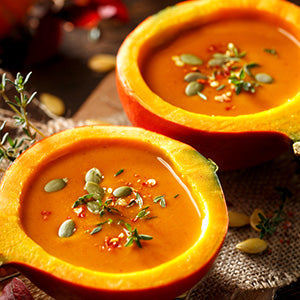10 Natural Ways to Lower Triglyceride Levels

If you've been diagnosed with high triglycerides, you're not alone. According to the U.S. Centers for Disease Control and Prevention, 21.5 percent of all adults have above-normal triglyceride levels, also called hypertriglyceridemia or dyslipidemia.[1] High levels of triglycerides may not come with specific symptoms, but they may coincide with both high total blood cholesterol and low HDL ("good") cholesterol levels. Having too many triglycerides in the blood can raise your risk of heart disease and insulin resistance,[2] especially if you also have high blood pressure or high cholesterol.[3]
The good news? Whether you currently have high triglycerides or it runs in the family and you want to keep your levels down, there are natural ways to keep them on an even keel.
What Are Triglycerides?
A triglyceride is a molecule with three fatty acids bonded with a glycerol molecule. Triglycerides are a common form of lipid (fat) in the plant and animal kingdoms. In general, most of the fats people eat contain triglycerides — including animal fat, plant oils, unsaturated fat, and trans fat.
When your meal contains more calories than you burn, your body stores triglycerides in your fat cells, or adipocytes, for future use.[2] These adipocytes form your adipose tissue, or body fat. Triglycerides also circulate through your bloodstream, which allows your healthcare provider to detect them in blood tests.
What Causes High Triglycerides?
The two most common causes of high triglycerides are eating a high-fat diet — especially animal fats — and being overweight. Other things that can cause high triglyceride levels include:
- Liver, thyroid, or kidney diseases[3]
- Type 2 diabetes
- Smoking cigarettes[4]
- Drinking alcohol[4]
- Medications like birth control pills and corticosteroids[3]
What Are Normal Triglyceride Levels?
Triglycerides below 150 milligrams per deciliter (mg/dL) of blood are considered normal. Anything above 150 mg/dL is considered elevated.[3] To assess triglyceride levels, doctors typically do a standard cholesterol blood test, which includes your triglycerides, total cholesterol, high-density lipoprotein (HDL, or "good") cholesterol, and low-density lipoprotein (LDL, or "bad") cholesterol.[3]
- Normal: Lower than 150 mg/ dL, or 1.7 mmol/L
- Borderline high: 150 to 199 mg/dL, or 1.8 to 2.2 mmol/L
- High: 200 to 499 mg/dL, or 2.3 to 5.6 mmol/L
- Very high: Greater than 500 mg/dL or above, or 5.7 mmol/L
How to Lower Triglycerides Naturally
If your triglycerides are high, there are natural ways to lower them without resorting to medications, which may have undesirable side effects. Research shows that the currently available drugs haven't shown the ability to significantly lower heart attack risk or some of the other concerns associated with high triglycerides.[5] Consider these natural remedies.
1. Limit Sugar
Limiting or even eliminating sugar — including natural sweeteners like agave, honey, or maple syrup — can lower your triglycerides. One study found that when obese women with a body mass index (BMI) of 25 or higher replaced sugar-sweetened beverages with plain water for nine months, it lowered their triglyceride levels from 155 mg/dL to 149 mg/dL.[6] Another study showed that eating food with added sugar created higher triglyceride levels in children.[7] If you crave a sweet snack, reach for fruit instead of sugar-sweetened foods. Try natural, no-calorie sweeteners like Stevia leaf or monk fruit, rather than items with added sugar. Although artificial sweeteners do not affect triglyceride levels, avoid them because they carry other harmful health consequences. If you want to cut sugar completely from your diet, check out our sugar detox article.
2. Eliminate Bread & Pasta
White bread, pasta, and Irish potatoes contain starch, a carbohydrate that has a high glycemic value that can spike blood sugar and raise your triglyceride levels. Eliminating these foods can help lower your triglycerides.[2] Focus on eating whole grains, such as wild rice, barley, or quinoa, and a variety of vegetables, nuts, and seeds, which contain complex carbohydrates and fiber.[3]
3. Exercise More & Differently
Since obesity and excess weight are linked to higher triglycerides, exercising is an obvious way to counteract high levels. Studies show that a combination of aerobic exercise and resistance training can reduce triglyceride levels and stimulate weight loss.[8] After reviewing many studies, scientists gave these specific recommendations: increase your physical activity to more than 30 minutes per day five times per week combined with moderate to high-intensity resistance training.[9] One study found that after one hour of exercising, triglyceride levels declined but not until after 24 hours in men who did not normally exercise.[10]
4. Avoid Saturated Fat & Trans Fat
To keep your triglycerides low, avoid animal fat and trans fat.[11] Animal-based food like red meat, butter, and cheese contain mostly saturated fat, which is linked to higher triglyceride levels.[12] Plant fat, including vegetable and nut oils, doesn't raise blood triglyceride levels as much as animal fat.[13] An exception to this rule? When vegetable oils are solidified through hydrogenation (margarine or shortening), they become "trans fat" and act similarly to animal fat in the body.[14]
Most fried and packaged foods, such as potato chips and cookies, contain trans fat.[15] The U.S. National Library of Medicine recommends making trans fat less than one percent and saturated fat less than 10 percent of your total fat intake. For the best results, avoid animal fat and trans fat altogether. Consume healthy fats, like extra virgin olive oil, coconut oil, or other plant-based options instead.
5. Try Bergamot Essential Oil
Some herbal supplements, such as bergamot essential oil, may help balance your triglyceride levels. One study found that taking a bergamot-derived extract for six months normalized both cholesterol and triglyceride levels.[16] Bergamot has high levels of flavonoids, which are plant pigments that offer many health benefits. Another study suggested that the plant's antioxidant properties — its ability to fight free radicals — may play a role in bergamot's influence on triglycerides.[17] Bergamot is a safe alternative treatment for patients who experience negative effects from pharmaceuticals.
6. Drink Less (or No) Alcohol
Not only does alcohol provide calories with no nutritive value, but it also raises your triglyceride levels.[18] The extra calories from alcohol get converted quickly into fat and stored in the body; your body fat is comprised mainly of triglycerides.[18] People with normal triglyceride levels risk raising them when drinking, even when done in moderation.[19] If you want to lower your levels, avoid alcohol.
7. Lose Weight
Losing weight lowers triglycerides because your body burns fat for energy and the extra gets eliminated. Several studies have shown that weight loss leads to lower triglyceride levels. People with type 2 diabetes who dropped 5 to 10 percent of their body weight over one year saw a 40 mg/dL drop in triglyceride levels.[20] In another study, the blood lipid levels of men with metabolic syndrome (pre-diabetes) decreased as they lost weight.[21] Numerous dietary plans can help you lose weight but be wary of "low-fat" diets, because studies show that your body needs fat, and those diet plans typically rely on packaged, processed food. Low-carb diets such as Keto or a plant-based diet will give you better results for weight loss and overall health. Check out these tips for weight loss.
8. Eat Foods That Lower Triglycerides
If you're wondering how to lower triglycerides through dietary changes, try the following foods.
Oats
You may be happy to learn that your morning oatmeal can naturally lower triglycerides, as long as it's whole-grain, rather than instant. Researchers discovered that eating high-fiber oats lowered triglycerides more than wheat cereals.[22] Scientists have linked fiber with a lowered risk of cardiovascular diseases, and oats are an excellent source of dietary fiber. You can also try steel-cut oats.
Beans
Not only are beans and other legumes a great source of fiber and nutrients, but they also lower triglycerides. Adults who ate two servings of beans to one serving of white rice (2:1) had lower triglycerides, lower blood pressure, and lower fasting glucose levels compared to those who ate more rice than beans.[23] Several other studies have found that beans lower cholesterol and triglyceride levels.[24]
Avocados
Whether you prefer to add them on top of whole-grain toast or serve them in guacamole, avocados are a natural defense against high triglycerides. Eating extra avocados for seven days lowered both triglyceride and cholesterol levels in one study of adults.[25] Avocados are chock full of healthy oils, including monounsaturated fat and polyunsaturated fat, and some researchers have suggested all people replace unhealthy saturated fat with avocados.[26]
9. Avoid Foods Linked to High Triglyceride Levels
People with high triglycerides should avoid refined sugar, soft drinks, fatty animal protein, high-fat dairy, and simple carbs like white bread and pasta. Always read the nutrition facts labels and watch out for added sugars. Manufacturers use different names for sugar, including dextrose, high fructose corn syrup, barley malt, and beet sugar. Generally, avoid these foods if you are concerned about your triglyceride levels:
- Red meat (beef, pork)
- Butter
- Cheese
- Soda and sugary drinks
- White bread
- Pasta
- Margarine and foods with trans fat
- Alcohol
Try Supplements to Lower Triglycerides
Some nutritional supplements may help balance your triglycerides. We mentioned bergamot oil above, but there are other supplements that may help. Studies have found that the following supplements may balance your triglyceride levels:
- Omega-3 fatty acids (select a plant-based option as opposed to fish oil)[27, 28]
- Chromium[29]
- Black cumin seed oil[30]
- Probiotic supplements
Risks of High Triglycerides
The main health risks from having high triglycerides are:
- Plaque buildup in the arteries
- Atherosclerosis (hardening of the artery walls)
- Heart attack
- Stroke
- Heart disease
- Insulin resistance
- Acute pancreatitis (sudden inflammation in the pancreas)
Points to Remember
There are several natural ways for you to lower your triglyceride levels, primarily dietary and lifestyle changes. Avoid eating sugary, packaged, and high-fat foods like red meat, butter, or cheese. Eliminate or lower your alcohol intake, as well as your consumption of refined carbs like pasta and white bread. Try to lose weight through dietary changes and exercise. Try a plant-based diet that includes healthful foods, such as oats, beans, and avocados, that promote normal triglycerides.
To lose weight and lower triglycerides at the same time, exercise more. Incorporate both cardiovascular (aerobic) exercise and strength or resistance training into your fitness regime. If you can lose 5 to 10 percent of your body weight, you will most likely reduce your blood triglyceride levels.
References (30)
- Carroll MD, et al. Trends in Elevated Triglyceride in Adults: United States, 2001–2012. U.S. Centers for Disease Control and Prevention. Updated 7 May 2015. Accessed 24 Sep. 2018.
- High Blood Triglycerides. National Heart, Lung, and Blood Institute, National Institutes of Health. Accessed 24 Sep. 2018.
- Very High Triglycerides. CardioSmart, American College of Cardiology. Accessed 24 Sep. 2018.
- Triglycerides. U.S. National Library of Medicine: MedlinePlus. Updated 8 Aug. 2018. Accessed 24 Sep. 2018.
- Hallén J, Sreeharan N. Development of Triglyceride-Lowering Drugs to Address Residual Cardiovascular Risk Strategic and Clinical Considerations. Eur Heart J Cardiovasc Pharmacother. 2018;4(4):237-242.
- Hernández-Cordero S, et al. Substituting water for sugar-sweetened beverages reduces circulating triglycerides and the prevalence of metabolic syndrome in obese but not in overweight Mexican women in a randomized controlled trial. J Nutr. 2014 Nov;144(11):1742-1752.
- Kell KP, et al. Added sugars in the diet are positively associated with diastolic blood pressure and triglycerides in children. Am J Clin Nutr. 2014;100(1):46-52.
- Gordon B, et al. The effects of exercise training on the traditional lipid profile and beyond. Curr Sports Med Rep. 2014;13(4):253-259
- Mann S, et al. Differential Effects of Aerobic Exercise, Resistance Training and Combined Exercise Modalities on Cholesterol and the Lipid Profile: Review, Synthesis and Recommendations. Sports Medicine (Auckland, N.z). 2014;44(2):211-221.
- Cullinane E, et al. Acute decrease in serum triglycerides with exercise: is there a threshold for an exercise effect?" Metabolism. 1982;31(8):844-847.
- Dhaka V, et al. Trans fats—sources, health risks and alternative approach - A review. J Food Sci Technol. 2011;48(5):534-541.
- Facts about Saturated Fats. U.S. National Library of Medicine: MedlinePlus. 4 April 2016. Accessed 24 Sep. 2018.
- Campbell TC. A plant-based diet and animal protein: questioning dietary fat and considering animal protein as the main cause of heart disease. J Geriatr Cardiol. 2017;14(5):331-337.
- Facts about Trans Fats. U.S. National Library of Medicine: MedlinePlus. 4 April 2016. Accessed 24 Sep. 2018.
- Toth PP, et al. Bergamot Reduces Plasma Lipids, Atherogenic Small Dense LDL, and Subclinical Atherosclerosis in Subjects with Moderate Hypercholesterolemia: A 6 Months Prospective Study. Front Pharmacol. 2015;6:299.
- Cappello AR, et al. Bergamot (Citrus bergamia Risso) Flavonoids and Their Potential Benefits in Human Hyperlipidemia and Atherosclerosis: an Overview. Mini Rev Med Chem. 2016;16(8):619-629.
- Klop B, et al. Alcohol and plasma triglycerides. Curr Opin Lipidol. 2013;24(4):321-326.
- Pownall HJ, et al. Effect of moderate alcohol consumption on hypertriglyceridemia: a study in the fasting state. Arch Intern Med. 1999;159(9):981-987.
- Wing RR, et al. Benefits of Modest Weight Loss in Improving Cardiovascular Risk Factors in Overweight and Obese Individuals With Type 2 Diabetes. Diabetes Care. 2011;34(7):1481-1486.
- Chan DC, et al. Effect of weight loss on markers of triglyceride-rich lipoprotein metabolism in the metabolic syndrome. Eur J Clin Invest. 2008;38(10):743-751.'
- Maki KC, et al. Effects of high-fiber oat and wheat cereals on postprandial glucose and lipid responses in healthy men. Int J Vitam Nutr Res. 2007;77(5):347-356.
- Mattei J, et al. A higher ratio of beans to white rice is associated with lower cardiometabolic risk factors in Costa Rican adults. Am J Clin Nutr. 2011;94(3):869-876.
- Polak R, et al. Legumes: Health Benefits and Culinary Approaches to Increase Intake. Clin Diabetes. 2015; 33(4): 198-205.25.
- López Ledesma R, et al. Monounsaturated fatty acid (avocado) rich diet for mild hypercholesterolemia. Arch Med Res. 1996;27(4):519-523.
- Peou S, Milliard-Hasting B, Shah SA. Impact of avocado-enriched diets on plasma lipoproteins: A meta-analysis. J Clin Lipidol. 2016 Jan-Feb;10(1):161-171.
- Leaf DA, Hatcher L. The effect of lean fish consumption on triglyceride levels. Phys Sportsmed. 2009;37(1):37-43.
- Shearer GC, et al. Fish oil — how does it reduce plasma triglycerides?" Biochim Biophys Acta. 2012;1821(5):843-851.
- Lee NA, Reasner CA. Beneficial effect of chromium supplementation on serum triglyceride levels in NIDDM. Diabetes Care 1994;17(12):1449-1452.
- Asgary S, et al. Ameliorative effects of Nigella sativa on dyslipidemia. J Endocrinol Invest. 2015; 38(10): 1039-1046.
- McKenney JM, Sica D. Role of prescription omega-3 fatty acids in the treatment of hypertriglyceridemia. Pharmacotherapy. 2007 May;27(5):715-728.
†Results may vary. Information and statements made are for education purposes and are not intended to replace the advice of your doctor. If you have a severe medical condition or health concern, see your physician.

Dr. Edward Group, DC
FOUNDER | HEALER | ADVOCATEDr. Group, DC is a healer and alternative health advocate, and an industry leader and innovator in the field of natural health who is dedicated to helping others. He is a registered doctor of chiropractic (DC), a naturopathic practitioner (NP), and proud alum of Harvard Business School and MIT Sloan School of Management. Dr. Group, DC is the founder of Global Healing – a mission and vision he has shared through best-selling books and frequent media appearances. He aims to spread his message of positivity, hope, and wellness throughout the world.










